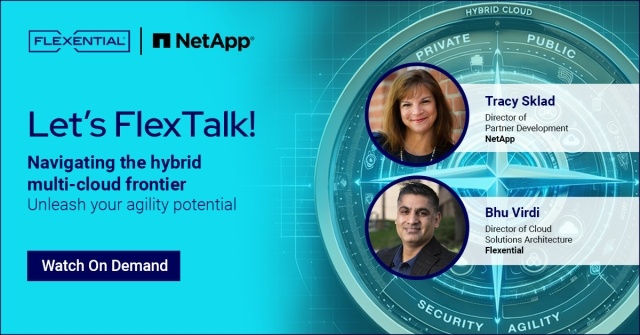The key steps to optimizing your multi-cloud strategy for business agility
As the business technology landscape continues to evolve, mastering the hybrid multi-cloud domain has become a pivotal factor in achieving operational success. This shift is driven by businesses' increasing desire to optimize their processes within a cloud environment that offers flexibility, scalability, and security.

However, the journey to an effective multi-cloud strategy is not without its share of hurdles. It requires a deep understanding of workloads, proficiency in managing data across various environments, and expertise in maintaining seamless connectivity.
In a recent webinar titled Navigating the hybrid multi-cloud frontier, Tracy Sklad, Director of Partner Development at NetApp joined our own Director of Cloud Solutions Architecture, Bhu Virdi, and shared insights on mastering the complexities of hybrid multi-cloud environments. The session covered the importance of workload optimization, cloud spend auditing and leveraging automation tools to streamline cloud operations. You can watch the full webinar on-demand here.
Understanding workload optimization
Understanding and optimizing workloads based on the environment they operate in, whether on-premises, virtual, or in the cloud, is crucial.
The cornerstone of a successful multi-cloud strategy lies in understanding your workloads. The nature of the workload, whether it’s SAP, file sharing, or high-performance computing, sets the bar for speed, performance, and data retrieval requirements. It's essential to scrutinize these workloads and determine their rightful place based on cost-effectiveness, business requirements, and the value they add.
Cloud spend auditing
Cloud spend auditing is a crucial yet often overlooked part of a successful multi-cloud strategy. Without regular audits, businesses risk inefficiencies like over-provisioned resources or unused instances, which can drive up costs. Auditing helps identify and eliminate these inefficiencies, ensuring cloud usage aligns with both performance needs and budget constraints.
In complex multi-cloud environments, where multiple vendors and pricing models come into play, unchecked cloud sprawl can lead to unnecessary expenses. Regular audits enable businesses to optimize their cloud infrastructure, making sure that every dollar spent supports operational goals. Leveraging automated tools and expert guidance further ensures cost-effective resource utilization while maintaining scalability and performance.
Enhancing performance monitoring and AI-driven analytics
Performance monitoring is another crucial element of a successful multi-cloud strategy. Solutions such as NetApp BlueXP offer comprehensive monitoring across all environments, providing insights into storage utilization and optimization. AI-driven analytics can further refine this by establishing auto-scaling policies, performance metrics, and business rules. However, this requires bridging the skill gaps within the organization, emphasizing the importance of continuous learning and upskilling.
The path to success in a multi-cloud environment
In today’s digital era, businesses are increasingly moving towards cloud-based solutions to streamline operations. However, transitioning to the cloud is not always straightforward, particularly when managing large, monolithic applications. Refactoring these applications for public cloud environments may be necessary, and businesses should assess the feasibility of using DevOps tools designed for public clouds in private environments.
“Most customers have a cloud commit, but not everybody knows what that means. If you're in the data center day-to-day, you may not know who your cloud peers are in your own company. You may not know what tools are available from the hyperscalers to move a workload from an on-prem environment to a public or private cloud. And what does that interconnectivity look like? So, whether it's robust networking or integration tools, those are the things that really are needed to make it seamless in these environments.”
— Tracy Sklad, Director of Partner Development, NetApp
Security considerations in a multi-cloud setup
Security is a key consideration in any multi-cloud strategy. A robust security policy, centralizing identity and risk management, conducting regular risk assessments, and implementing an incident response plan are all essential steps in maintaining data security. When choosing cloud providers for a hybrid strategy, businesses must evaluate their internal talent, workload types, network latency, and cost optimization.
Embracing the flexibility and scalability of multi-cloud
A well-implemented multi-cloud strategy offers businesses flexibility, scalability, and security—essential components of success in today’s digital economy. Transitioning to a cloud-based solution necessitates meticulous planning and consideration. Businesses are tasked with managing monolithic applications and ensuring data security, among other challenges. However, with the right strategy, tools, and expertise, businesses can streamline their cloud operations, reaping the benefits of augmented efficiency and agility in return.
Ready to take your multi-cloud strategy to the next level? Don’t miss out on the insights from our experts. Watch the webinar Navigating the hybrid multi-cloud frontier on demand now and discover how to unlock the full potential of agility and efficiency in your cloud operations.







